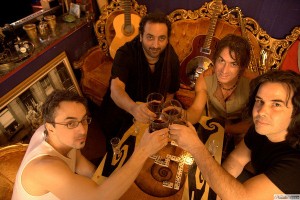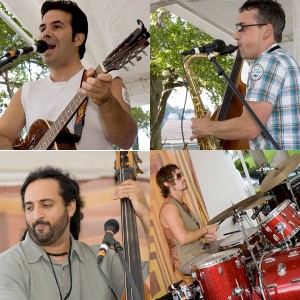
 Los Sugar Kings have been on the scene for seven years, and the Latino, rock, blues, world music influenced band are still going strong. In fact, they have got a second CD coming out soon. Patino Vazquez detailed the history of Los Sugar Kings up to their present day recording project.
Los Sugar Kings have been on the scene for seven years, and the Latino, rock, blues, world music influenced band are still going strong. In fact, they have got a second CD coming out soon. Patino Vazquez detailed the history of Los Sugar Kings up to their present day recording project.
“It morphed out of a band I was using as an experiment called Mondosweetie after I had taken some trips to Cuba,” he said. “I started discovering new sounds and rhythms. I made a record and invited musicians from the Boston area to play on it. They encouraged me to keep doing it and playing it out live.”
From theses performances, Vazquez pulled some of the players and suggested a side project called Los Sugar Kings, which is the name of a Cuban baseball team from the 1920s and 1930s, a suggestion from bass player Mikael Mersha. The Los Sugar Kings decided to use a drum set drummer instead of the traditional Latin percussion. They also brought in Danny Abreu on keyboards and saxophone, which changed the voicings of traditional Latin music. Everybody in the band is from a different country, Mersha, Ethiopia; Benny Benson, Ireland; Abreu, Portugal; and Vazquez, Cambridge.
“We would just go out and do gigs as Los Sugar Kings and eventually it just became a habit,” Vazquez said. “We’re on our seventh year now.” Drummer Benny Benson, of Beverly, Massachusetts, set up Los Sugar Kings’ first residency at the now defunct Edgewater Café in Salem, Massachusetts. “That was our rehearsal and we experimented a lot. Sometimes we were too loud. We learned what worked and what didn’t,” Vazquez allowed.
Los Sugar Kings do not often play clubs that feature Latino music but find their best audiences at rooms like Johnny D’s in Somerville, Massachusetts. “We didn’t want to just get stuck playing Latin clubs,” he said. “In fact, we rarely do that now. Latin audiences are a little pickier. If they’re from the Dominican Republic, they want to hear merengue exactly the way they remember the merengue. They start making demands on the music. We want to be a little more free. So, the model that we use is a little more like the jazz model, we go in and improvise on our theme. We always try to stay true to the groove of the clave, which is the basic element in salsa. But we try to do everything we can to expand on that and bring in different voices.”
Los Sugar Kings’ upcoming CD Beautiful Stories will feature their songs “Force Of Nature,” which isn’t strictly Latin or world music. It is not in any box. “We’re doing a lot more of that lately,” Vazquez said. “It’s an attempt to build bridges and crossover some more. ‘Force Of Nature’ uses a song clave. It’s got the three-two. That clave is a Cuban clave, and it got picked up in New Orleans. It was used in some of the early New Orleans rhythms. Then, it got absorbed by Bo Diddley. Bo Diddley made it famous. A lot of British musicians started calling it ‘Bo Diddley beat.’ You hear it in The Who and you hear it in The Rolling Stones.”
Cuban bands swing around that beat and American and British bands play on top of it. “We just took that concept and built a song around that idea, which brings it all back home too. I wanted to bridge that gap. This really is a Cuban rhythm.”
Los Sugar Kings have another song, “Fuego Dulce” that has a mambo beat and some elements of flamenco. “The poetry in the lyrics is based on Spanish poet Federico Lorca’s poem about Cuba,” Vazquez said.
“On that one we have a guest percussionist, Miguel Veato, and he is playing bongos and cencerro, which is the cowbell. He opens with congas.” The beat sways and swings and moves around and is called tubao, which is played by the congas and the bass.
“They have this little conversation where they create this little pocket. So, they’re both swinging around the clave, which is the basic element, and it’s a two-three clave, so it’s a rumba clave. The bass is also playing another swing pattern that doesn’t step on the clave or the congas. All the other instruments, guitar and piano, is playing montuno. The montuno creates another pocket that also weaves into the little wholes between the congas and the bass. Everyone plays a little tiny part to create this fabric.”
Another song “No Se No Se” sounds a bit like Santana with electric guitar over Latin rhythms. “That one is based on a Spanish interpretation” of Cuban music. “(Spain’s city of)Catalunya started bringing rumba from Cuba, and they started adapting those beats into their music. They were bringing the flamenco guitars into in. They were creating this music that is peculiar to that region called rumba flamenca. It uses Spanish guitars and Cuban rhythms and you can dance to it the way you can dance to Cuban son.”
The difference is that Cuban music uses a lot of upbeats while the Spanish version puts the accent on the down beats. “That strum creates a more steady pattern in the metronome. It’s closer to the quarter note metronome pattern than to the clave. You can play the clave inside there but the guitar is keeping it pretty straight.”
Vazquez is a first generation Cuban-American. He has been to Cuba for visits several times since 1978. He went as a child to visit family in his parents’ home land. Vasquez’s father participated in the Bay of Pigs invasion and spent two years in a Cuban prison. This made the political climate in their first American city of Miami, with its constant talk about invasions, uncomfortable for the family, so they moved to Boston.
Vasquez was raised in Arlington, Massachusetts, and his family didn’t listen to Cuban music in the house. “My mom was a hippie and she collected cool records like The Rolling Stones and The Beatles and Santana. I was listening to that. She was a classically trained pianist in Cuba, and she would play classical music and occasionally play Cuban music on piano. That was the only Cuban music I heard in the house, what she played on the piano. Some of those songs were classical in composition but they were based on Cuban folk rhythms and songs.”
When Vazquez was in his 20s, he heard a singer named Filzio Rodriquez who was one of the founders of Nueva Trova, or new troubadour, a movement that started in Chile. Cuban artists like Filzio Rodriquez created a response to that.
“I heard him, and I was just blown away, by the lyrics and the guitar playing and the melodies, and the emotion he evoked just completely altered my direction in music. Before, I was just playing blues-based rock music. I switched gears completely, and I learned to play the Spanish guitar and play with my fingers and finger pick and write and sing in Spanish. Then I started listening to the dance music and got hooked on that. That’s what lead to the Mondosweetie experiments and The Los Sugar Kings being born.”
Vazquez does not just play guitar. He plays the Cuban stringed instrument called tres. The instrument was developed by Cubans after the Spanish government stopped shipping in guitars during a time of rebellion. It uses three doubled strings and it is tuned to an open C, and the G is where the low e is on the guitar.
“The lowest tone on the tres is where the highest tone is on the guitar,” he said.
Each time Vazquez goes back to Cuba, he gets inspired to write new songs. He hasn’t been back to Cuba in five years, so his next Los Sugar Kings CD will feature more English songs.
The next Los Sugar Kings CD will find, aside from being in English, will feature Latin rhythms supporting English language lyrics and American grooves supporting Spanish lyrics. Vazquez’s plan or vision going into the studio was to put less emphasis on dance rhythms. The band also took their time, recording their songs in their PennyCo studio, which is in the keyboard player’s house. “I think we ended up with something very different from the first record.”

